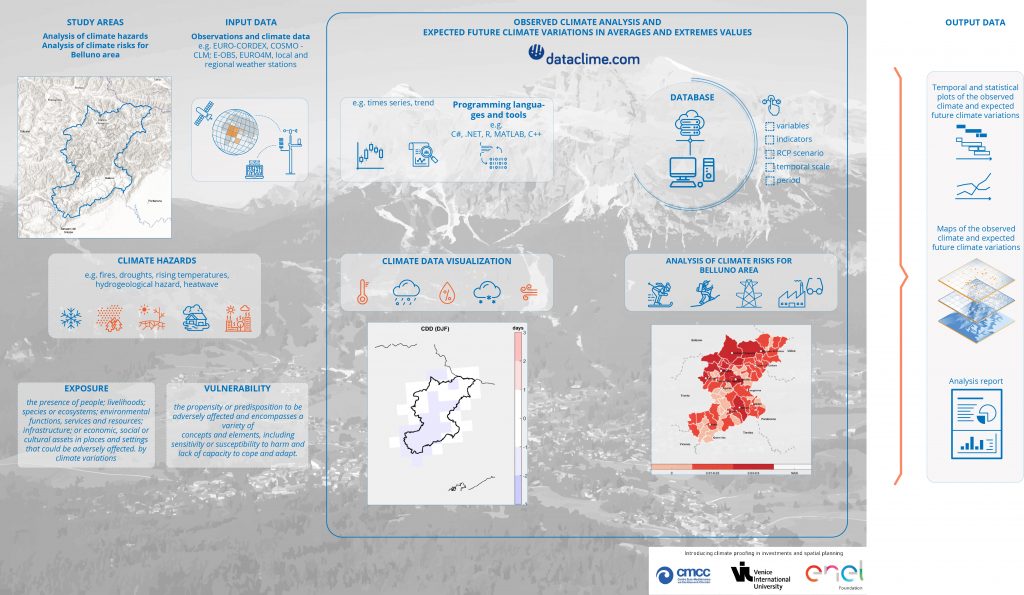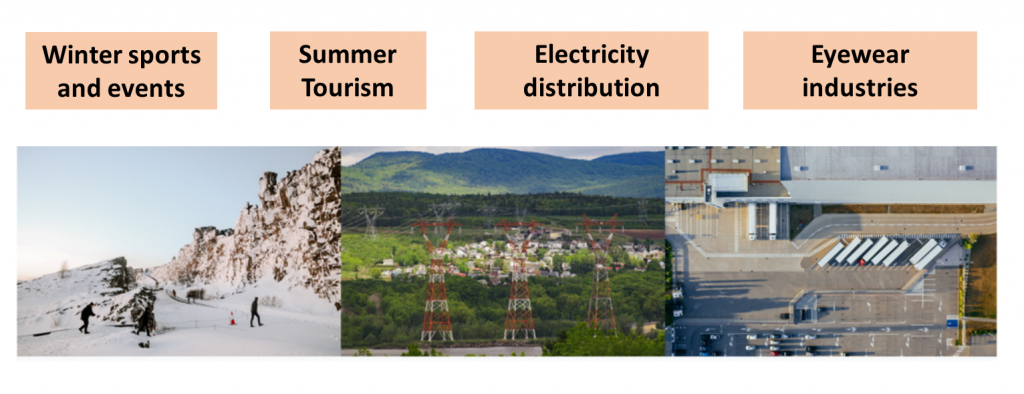Infrastructure and Electrical Networks: Analysis of Climate Risk for Four Economic Sectors of Interest in the Province of Belluno

Goals
The main goal of the pilot project “Introducing climate proofing in investments and spatial planning”, supported by and with the scientific contribution of ENEL Foundation, involved the climate risk assessment by considering key four economic sectors for the Belluno province: Summer Tourism, Winter sports and events, Eyewear Industry and Electricity Distribution.
The socio-economic risk assessment has been carried out by Venice International University (VIU), in collaboration with the Euro-Mediterranean Center on Climate Change (CMCC) for the simulation of climate scenarios and hazard assessment and e-distribuzione for electrical distribution infrastructure exposure and vulnerability analyses.
The methodology uses a multi‐hazard approach that combines classical spatial risk assessment and socio‐economic analysis and valuation to estimate damage associated with potential risks of different kinds and magnitude. The study identifies, qualitatively and quantitatively, the hazards threatening the area, its production activity, and all those receptors that are directly or indirectly exposed to them, at a residential, industrial, infrastructural, logistical, and productive level.
Carried out activities
Activities focused on:
- The hazard assessment (current and expected climate) was analyzed through a wide range of climate indicators * defined on the basis of literature studies and users of the various economic sectors analyzed. In particular, the expected climatic variation of these climate indicators (very rainy days, heat waves, wind storms, etc.) was obtained by considering different high-resolution climate models. The same indicators were therefore evaluated in the historical period considering the local meteorological data made available by ArpaV.
- The exposure assessment focused on four main receptors potentially exposed to climatic events in the socio-ecological system of Belluno province: (a) the tourism sector, and in particular its accommodation facilities and infrastructures; (b) the eyewear industrial sector; (c) infrastructures for public services and in particular those of electricity suppliers; (d) sport events planned for the near future, and in particular the Winter Olympics and 2026.
- The vulnerability assessment identified by evaluating three components: (a) the capacity to manage adverse events when they occur, (b) the capacity to anticipate and adapt to them and (c) the susceptibility to climate hazard.
The risk analysis aims at assessing climate risk at the local level, allowing “climate-proofing” plans and decisions for different receptors, taking into account multiple hazards, their evolution and the potential hazards deriving from future climate scenarios.

Dataclime functionalities
Dataclime platform gives the possibility to view and download all the hazard maps (3 different IPCC scenarios, two time periods and 70 hazard indicators regarding precipitation, temperature, wind, snow) , exposure, vulnerability and risk maps based on the economic sector of interest (Summer Tourism, Winter sports and events, Eyewear Industry and Electricity Distribution).
Reference:
https://papers.ssrn.com/sol3/papers.cfm?abstract_id=4080578
Link:
https://www.univiu.org/viu-life/news-archive/2161-climate-proofing-in-investments-and-spatial-planning
https://www.enelfoundation.org/topics/articles/2020/04/climate-proofing-in-investments-and-spatial-planning
https://www.enelx.com/content/dam/enel-found/navigant/cidD49862B0-4154-4171-BFE1-A9C3CCE0E1A5.pdf
https://corrierealpi.gelocal.it/belluno/cronaca/2020/08/07/news/resistere-ai-cambiamenti-climatici-belluno-con-vaia-ha-indicato-la-strada-1.39171834
https://www.enelfoundation.org/all-news/news/2021/10/assessing-disaster-risk-reduction-in-the-dolomites-area
Note:
*Climate indicators are synthetic parameters obtained from different atmospheric variables (temperature, precipitation) aimed at analyzing the main characteristics of the extreme atmospheric events with the greatest impact whose evolution in the future climate is to be studied (Reder, A. et al ., 2018). Climate indicators mainly describe the intensity and frequency of extreme events in terms of precipitation and temperature, and are useful for subsequent sector studies aimed at evaluating the main local impacts of climate change on which adaptation strategies are based


